CITROEN DS3 CABRIO DAG 2016 Handbook (in English)
Manufacturer: CITROEN, Model Year: 2016, Model line: DS3 CABRIO DAG, Model: CITROEN DS3 CABRIO DAG 2016Pages: 458, PDF Size: 14.51 MB
Page 71 of 458

69
DS3_en_Chap02_ouvertures_ed01-2015
Boot
Opening
F After unlocking the vehicle, press the o
pening control and raise the tailgate.
Closing
F Lower the tailgate using the interior grab han
dle.
If
the tailgate is not closed correctly:
-
w
hen the engine is running ,
this
warning lamp comes on,
a
ccompanied by a message in
t
he multifunction screen for a few
se
conds,
-
w
hen the vehicle is moving (speed above
6
mph (10 km/h)), this warning lamp comes
o
n, accompanied by an audible signal and
a
message in the multifunction screen for a
f
ew seconds. System
for mechanical unlocking of the boot
i
n the event of a battery or central locking
m
alfunction.
Tailgate release
Unlocking
F Fold back the rear benchseat to gain a
ccess to the lock from inside the boot.
F
I
nsert a small screwdriver into hole A of the
lock
to unlock the tailgate.
Access
Page 72 of 458

DS3_en_Chap03_confort_ed01-2015
Comfort
Page 73 of 458

DS3_en_Chap03_confort_ed01-2015
Page 74 of 458
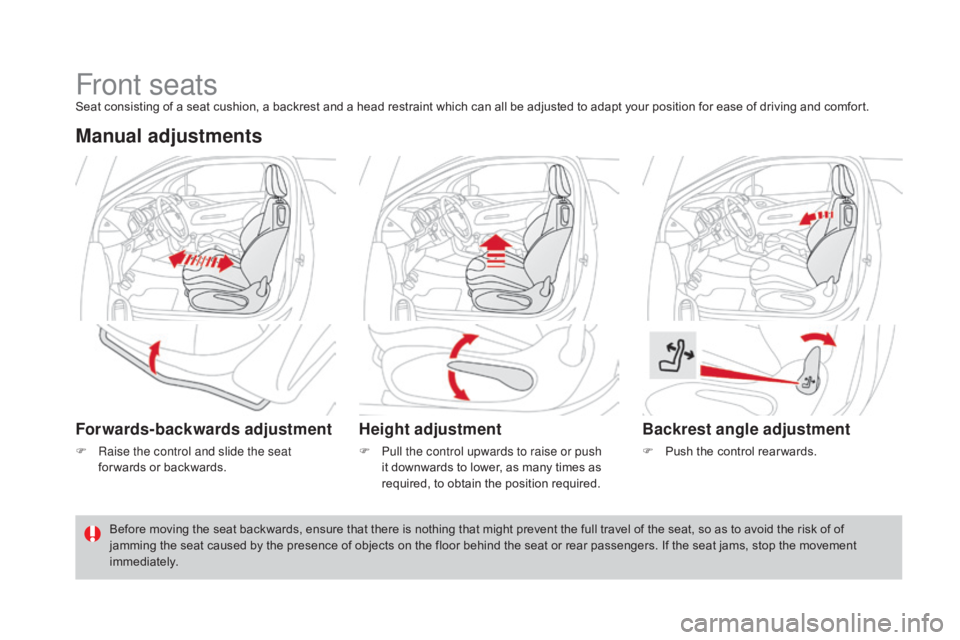
DS3_en_Chap03_confort_ed01-2015
Front seatsSeat consisting of a seat cushion, a backrest and a head restraint which can all be adjusted to adapt your position for ease of driving and comfort.
Manual adjustments
Forwards-backwards adjustment
F Raise the control and slide the seat for wards or backwards.
Height adjustment
F Pull the control upwards to raise or push it downwards to lower, as many times as
r
equired, to obtain the position required.
Backrest angle adjustment
F Push the control rear wards.
Before
moving
the
seat
backwards,
ensure
that
there
is
nothing
that
might
prevent
the
full
travel
of the seat, so as to avoid the risk of of
j
amming
the
seat
caused
by
the
presence
of
objects
on
the
floor
behind
the
seat
or
rear
passengers. If the seat jams, stop the movement
i
mmediately.
Page 75 of 458
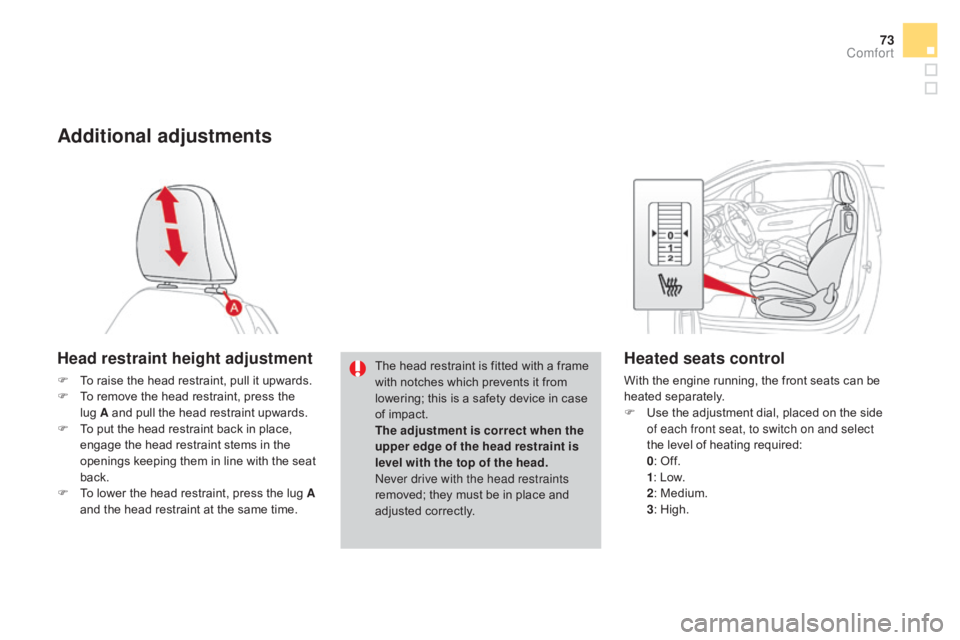
73
DS3_en_Chap03_confort_ed01-2015
Additional adjustments
Head restraint height adjustment
F To raise the head restraint, pull it upwards.
F T o remove the head restraint, press the
l
ug A and pull the head restraint upwards.
F
T
o put the head restraint back in place,
e
ngage the head restraint stems in the
o
penings keeping them in line with the seat
b
ack.
F
T
o lower the head restraint, press the lug A
and
the head restraint at the same time.The
head restraint is fitted with a frame w
ith notches which prevents it from
l
owering; this is a safety device in case
o
f impact.
The adjustment is correct when the
upper edge of the head restraint is
level with the top of the head.
Never drive with the head restraints
removed;
they must be in place and
adj
usted
c
orrectly.
Heated seats control
With the engine running, the front seats can be heated s eparately.
F
U
se the adjustment dial, placed on the side
o
f each front seat, to switch on and select
the
level of heating required:
0:
Off.
1:
Low.
2:
Medium.
3:
High.
Comfort
Page 76 of 458
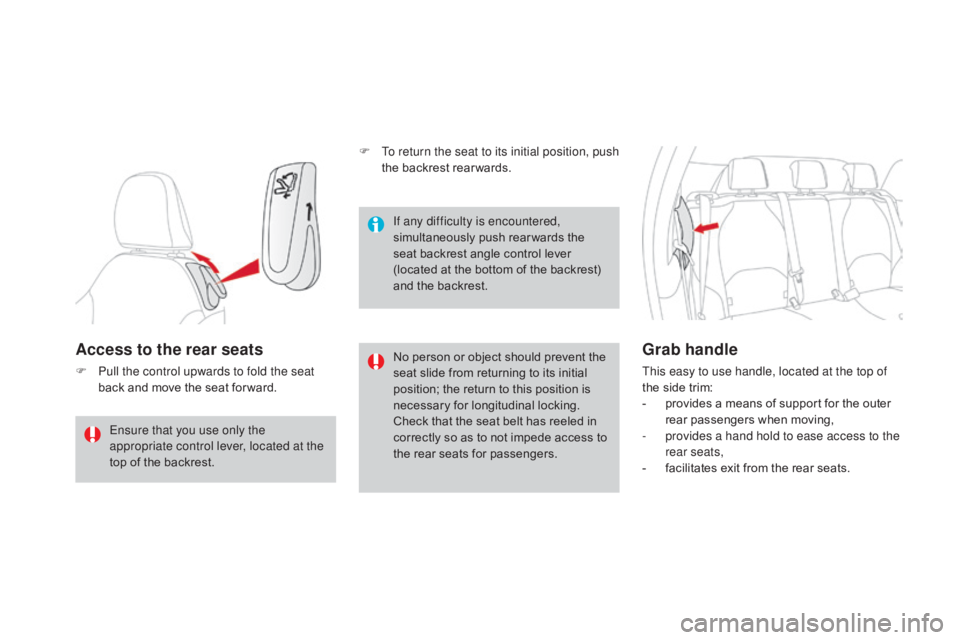
DS3_en_Chap03_confort_ed01-2015
Access to the rear seats
F Pull the control upwards to fold the seat back and move the seat for ward. No
person or object should prevent the s
eat slide from returning to its initial
p
osition; the return to this position is
n
ecessary
fo
r
l
ongitudinal
l
ocking.
Check
that the seat belt has reeled in
c
orrectly so as to not impede access to
t
he rear seats for passengers.
grab handle
This easy to use handle, located at the top of
the side trim:
-
p
rovides a means of support for the outer
r
ear
p
assengers
w
hen
m
oving,
-
p
rovides a hand hold to ease access to the
rear seats,
-
f
acilitates exit from the rear seats.
If any difficulty is encountered,
simultaneously
p
ush
r
earwards
t
he
s
eat
backrest
angle
control
lever
(
located
at
the
bottom
of
the
backrest)
a
nd
the
backrest.
Ensure that you use only the
appropriate control lever, located at the
top
of
the
backrest. F
T
o return the seat to its initial position, push
the
backrest
rear wards.
Page 77 of 458
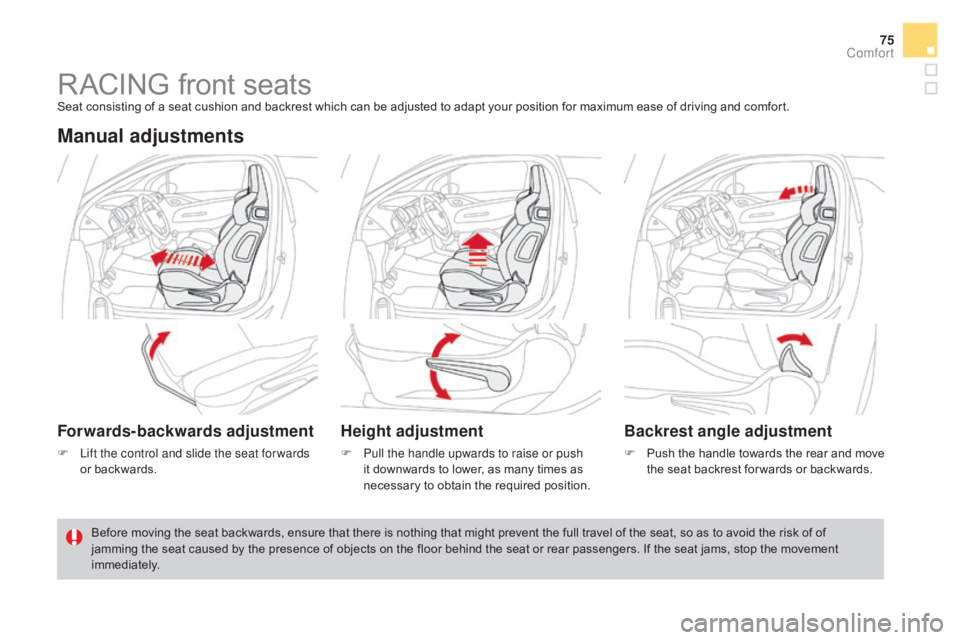
75
DS3_en_Chap03_confort_ed01-2015
RACING front seatsSeat consisting of a seat cushion and backrest which can be adjusted to adapt your position for maximum ease of driving and comfort.
Manual adjustments
Forwards-backwards adjustment
F Lift the control and slide the seat for wards or backwards.
Height adjustment
F Pull the handle upwards to raise or push it downwards to lower, as many times as
n
ecessary to obtain the required position.
Backrest angle adjustment
F Push the h andle t owards t he r ear a nd m ove t
he seat backrest for wards or backwards.
Before
moving
the
seat
backwards,
ensure
that
there
is
nothing
that
might
prevent
the
full
travel
of the seat, so as to avoid the risk of of
j
amming
the
seat
caused
by
the
presence
of
objects
on
the
floor
behind
the
seat
or
rear
passengers. If the seat jams, stop the movement
i
mmediately.
Comfort
Page 78 of 458
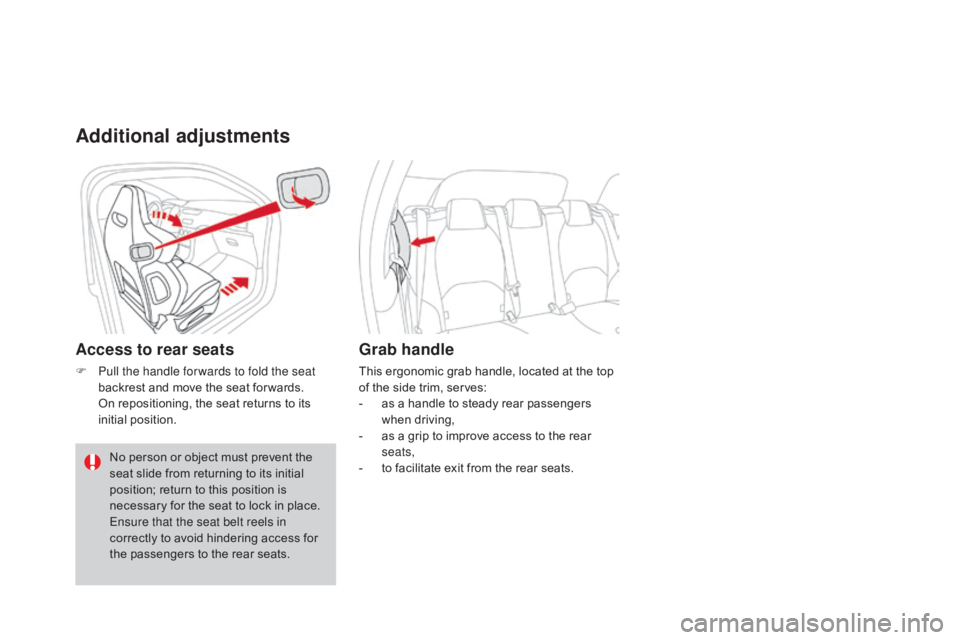
DS3_en_Chap03_confort_ed01-2015
Additional adjustments
Access to rear seats
F Pull the handle for wards to fold the seat backrest and move the seat for wards.
O
n repositioning, the seat returns to its
in
itial
p
osition.
grab handle
This ergonomic grab handle, located at the top of the side trim, serves:
-
a
s a handle to steady rear passengers
w
hen
d
riving,
-
a
s a grip to improve access to the rear
sea
ts,
-
t
o facilitate exit from the rear seats.
No
person
or
object
must
prevent
the
s
eat
slide
from
returning
to
its
initial
p
osition;
return
to
this
position
is
n
ecessary
for
the
seat
to
lock
in
place.
Ensure that the seat belt reels in
correctly
to
avoid
hindering
access
for
t
he
passengers
to
the
rear
seats.
Page 79 of 458
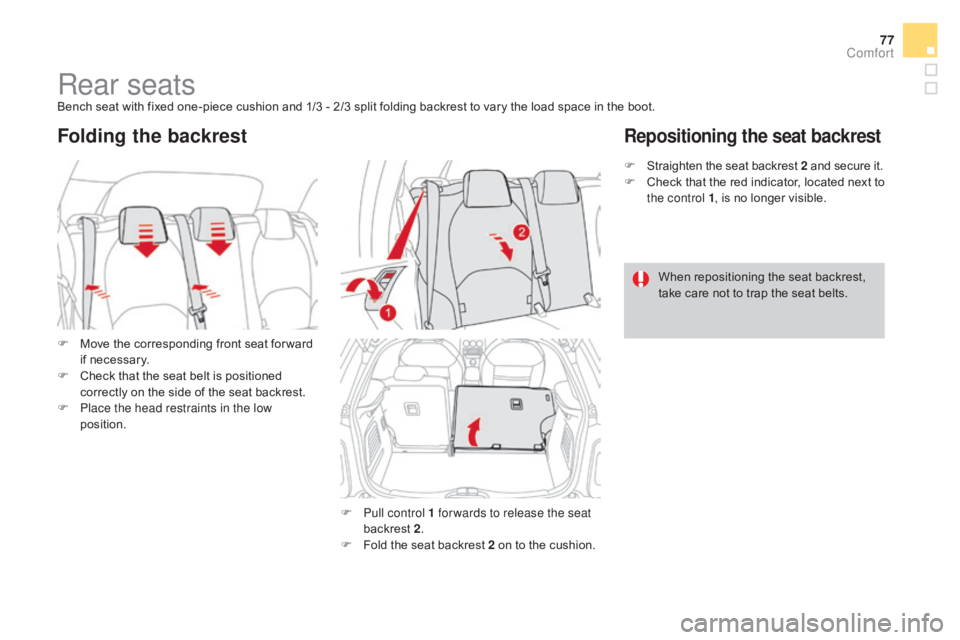
77
DS3_en_Chap03_confort_ed01-2015
Rear seatsBench seat with fixed one-piece cushion and 1/3 - 2/3 split folding backrest to vary the load space in the boot.
F
M
ove the corresponding front seat for ward
i
f necessary.
F
C
heck that the seat belt is positioned
c
orrectly on the side of the seat backrest.
F
P
lace the head restraints in the low
position.
Folding the backrest
F Pull control 1 for wards to release the seat backrest 2.
F
F
old the seat backrest 2 on to the cushion.F
S
traighten the seat backrest 2
and secure it.
F
C
heck
t
hat
t
he
r
ed
i
ndicator,
l
ocated
n
ext
t
o
t
he control 1
, is no longer visible.
Repositioning the seat backrest
When repositioning the seat backrest, t
ake care not to trap the seat belts.
Comfort
Page 80 of 458

DS3_en_Chap03_confort_ed01-2015
These have one position for use (up) and a stowed position (down).
They
can also be removed.
To
remove a head restraint:
F
r
elease the backrest using control 1,
F
t
ilt the backrest 2 slightly for wards,
F
p
ull the head restraint upwards to the stop,
F
t
hen, press the lug A.
Rear head restraints
Never drive with the head restraints
removed;
they must be in place and
c
orrectly
adj
usted.
Steering wheel ad justment
F When stationary , pull the control lever to
release the adjustment mechanism.
F
A
djust the height and reach to suit your
d
riving position.
F
P
ush the control lever to lock the
a
djustment
m
echanism.
As a safety precaution, these
operations should only be carried out
with
the vehicle stationary.